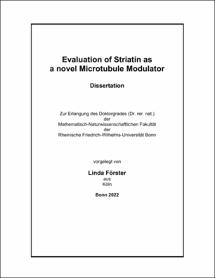Evaluation of Striatin as a novel Microtubule Modulator

Evaluation of Striatin as a novel Microtubule Modulator

| dc.contributor.advisor | Gruß, Oliver | |
| dc.contributor.author | Förster, Linda | |
| dc.date.accessioned | 2023-04-13T13:28:47Z | |
| dc.date.available | 2023-04-13T13:28:47Z | |
| dc.date.issued | 13.04.2023 | |
| dc.identifier.uri | https://hdl.handle.net/20.500.11811/10767 | |
| dc.description.abstract | The dynamics of the cell cycle and cell division are governed by tubulin polymers, i. e. microtubules (MTs). Defects of MT assembly or disassembly lead to pathogenic cellular conditions, negatively affecting cell viability, cell shape, migration and genomic stability. Previously, our lab established a screen for so far unknown mitotic and meiotic MT modulators. In this project, I distinguish, characterize and localize novel MT associated proteins (MAPs) and MT modulators, including Striatin (STRN).
STRN is described as a regulating platform subunit in a kinase and phosphatase-harbouring complex called STRIPAK (Striatin phosphatase and kinase complex). A key component of this complex, Protein Phosphatase 2 A (PP2A), is known to play a major role in cell division progression also as MT dynamics regulator. In association with PP2A, STRN could function as a regulatory PP2A subunit for a tight posttranslational modification (PTM)-switch of yet unknown STRN interactors that function as MAPs. An interaction partner analysis by co-immunoprecipitation and binding partner analysis by mass spectrometry might address this question. Indeed, the STRN interactome in my work shows multiple partnerships to known MAPs. I further compare in vivo models, like the embryonic IMR-90 fibroblasts cell line with cell cycle-arrested Xenopus leavis egg extracts and find STRN-related similarities. I analyze the consequences of the lack of STRN in both models and in different cell cycle stages. STRN depletion in mitotic Xenopus laevis extracts stabilizes spindle structures. In human embryonic lung fibroblasts a CRISPR knock out (KO) of STRN decelerates mitotic progression and the cells stay longer in G2/M-, pro- and especially in metaphase. Together with my results various facts suggest STRN has different roles in the cell regarding MT dynamics and ciliogenesis. | en |
| dc.language.iso | eng | |
| dc.rights | In Copyright | |
| dc.rights.uri | http://rightsstatements.org/vocab/InC/1.0/ | |
| dc.subject | mitosis | |
| dc.subject | striatin | |
| dc.subject | cell division | |
| dc.subject.ddc | 570 Biowissenschaften, Biologie | |
| dc.title | Evaluation of Striatin as a novel Microtubule Modulator | |
| dc.type | Dissertation oder Habilitation | |
| dc.publisher.name | Universitäts- und Landesbibliothek Bonn | |
| dc.publisher.location | Bonn | |
| dc.rights.accessRights | openAccess | |
| dc.identifier.urn | https://nbn-resolving.org/urn:nbn:de:hbz:5-70423 | |
| ulbbn.pubtype | Erstveröffentlichung | |
| ulbbn.birthname | Linda Förster | |
| ulbbnediss.affiliation.name | Rheinische Friedrich-Wilhelms-Universität Bonn | |
| ulbbnediss.affiliation.location | Bonn | |
| ulbbnediss.thesis.level | Dissertation | |
| ulbbnediss.dissID | 7042 | |
| ulbbnediss.date.accepted | 13.01.2023 | |
| ulbbnediss.institute | Mathematisch-Naturwissenschaftliche Fakultät : Fachgruppe Biologie / Institut für Genetik | |
| ulbbnediss.fakultaet | Mathematisch-Naturwissenschaftliche Fakultät | |
| dc.contributor.coReferee | Witke, Walter | |
| ulbbnediss.contributor.gnd | 1329350324 |
Dateien zu dieser Ressource
Das Dokument erscheint in:
-
E-Dissertationen (4397)




